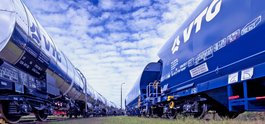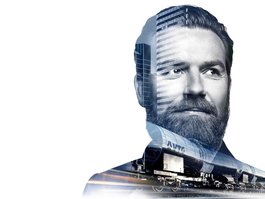When the superstructure can be swapped for another one, a wagon is no longer limited to just a single transportation purpose. Depending on individual transport needs, there are all kinds of ways to mix and match the different “building blocks”. This modular design makes logistics generally more flexible, as well increasing both the usability of rolling stock and the utilization of its capacity throughout its entire lifecycle. “Standard issue is a thing of the past,” says Sven Wellbrock, Chief Operating Officer Europe & Chief Safety Officer at VTG AG. “We want to give our customers integrated and, above all, made-to-measure solutions that make the best use of assets, logistical services and digital services. Modular solutions establish rail freight as an integral component of the supply chain.”
The modularization of freight traffic
The new “Modular Solutions” transport concept gives VTG a business model that is sustainable, flexible and rigorously customer centric. “Our job is to completely rethink the freight wagon, including all our services and business models,” explains Torben Jaeger, Head of VTG Europe Solutions. “Most rail freight wagons are built and licensed for one specific purpose. But with the market growing ever more agile, that is not always what you need. We no longer think in terms of wagons and products, but in terms of solutions.” Being able to individually combine modular superstructures with all commercially available intermodal wagons naturally maximizes the potential applications. But it also means that assets can be made available more quickly. For example, wagons that normally only have seasonal applications no longer have to spend the rest of the year standing idle in the depot. Moreover, modular wagons also make repair processes more efficient: If a container is defective, it is no longer necessary to send the whole wagon to the workshop, as an intact container can simply be placed on the existing platform. The same principle applies if the wagon itself is defective: Here again, the container can be moved to another wagon and the customer’s transports can continue uninterrupted. Idle time as a whole can thus be reduced.
The m2 wagon concept developed jointly by VTG and DB Cargo goes even further: “The m2 platform gives us modular underframes, too, which let us adjust wagons to any length,” says Dr. Hanno Schell, Head of Technical Innovations at VTG AG. The primary aim is to maximize flexibility. And thanks to its modular design, the flat wagon can be adapted again and again to changing conditions and requirements: The length, bogie and braking configuration can all be selected and modified individually in line with specific needs.
Broad modular portfolio
These tailor-made modular solutions are already available to a wide range of industries. Customers can choose the platforms and superstructures they prefer for all kinds of freight, from steel products to timber to bulk cargos. An extensive spectrum of tank containers is also ready and waiting to transport liquid and gaseous products.
Flexible underframes, flexible superstructures, flexible services: VTG goes modular
Contact us
If you have any questions regarding our press releases, please don't hesitate to contact us.
Email




